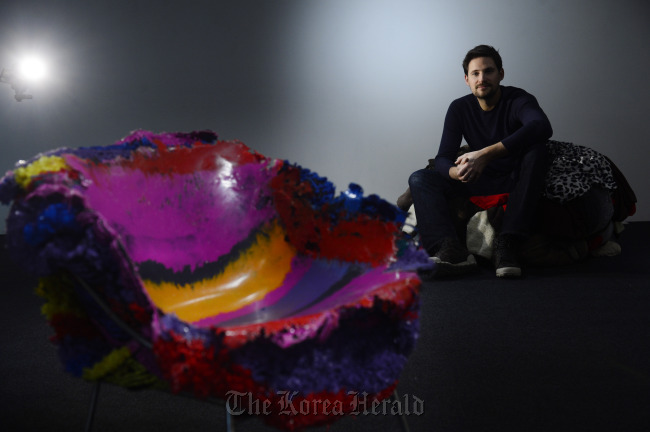British sculptor sits somewhere between design and art
Tom price’s sculptural plastic chairs to be showcased for the first time in Seoul
By Lee Woo-youngPublished : Nov. 15, 2012 - 18:58
British artist Tom Price makes chairs: not ordinary comfy ones sold at furniture stores, but those with a sculptural appearance, which may cause viewers to question their functionality and comfort. They can also be put in a living room, which will be sure to establish a unique mood in one’s home.
Making the chairs involves a long and complicated process. From the initial idea to choosing materials and finding a way to apply them to chairs, the process involves artistic exploration of materials and methods.
In the “Meltdown Chair,” a part of his Meltdown series of furniture, Price wraps blue polypropylene ropes around a beach ball, takes out its core and makes a seat with a heated mold. After the process of hardening completes, it is transformed into a chair that wouldn’t be seen anywhere else.
Having studied both design and art in England, Price explores the grey area between the two fields and continues to test common materials, such as plastic, and what they can turn out to be.
Ten of his chairs will be showcased for the first time in Seoul at Arario Gallery Cheongdam from Nov. 20-Dec. 30 along with a painting and a large installation.
Making the chairs involves a long and complicated process. From the initial idea to choosing materials and finding a way to apply them to chairs, the process involves artistic exploration of materials and methods.
In the “Meltdown Chair,” a part of his Meltdown series of furniture, Price wraps blue polypropylene ropes around a beach ball, takes out its core and makes a seat with a heated mold. After the process of hardening completes, it is transformed into a chair that wouldn’t be seen anywhere else.
Having studied both design and art in England, Price explores the grey area between the two fields and continues to test common materials, such as plastic, and what they can turn out to be.
Ten of his chairs will be showcased for the first time in Seoul at Arario Gallery Cheongdam from Nov. 20-Dec. 30 along with a painting and a large installation.

During his visit to Korea, Price talked to The Korea Herald on Wednesday about what is it like sitting in the grey area between design and art, why he chose chairs and plastics as key subjects in his work and his artistic activities in discovering identity and significance of materials.
KH: Do you sell your work at furniture shops or can they be viewed only at galleries?
Price: I sell them to collectors, galleries and museums. But people can buy them for their homes because they are designed to be used. I always make sure they are strong enough and comfortable and usable. They are not comfy cushion chairs, but are meant to be used.
KH: Are the chairs artwork or furniture?
Price: Yes and no. They are not designed for large-scale production. So in that sense, they can only be made by me or by my studio. But I think people buy them because it can be a certain statement in their home or exhibition. Chairs have always been a statement. It was a symbol of authority and status in the old days. You can see it through how chairs made in Egyptian times had a significant structures and carvings with social, political and religious meanings.
KH: What’s the significance of making chairs?
Price: I think chairs and furniture are somewhere between fashion and architecture. Fashion design is about what goes on the body and stays on the body for a long time. Architecture is further removed from the body, but still it has to accommodate people and their movements. And chairs are something you have direct contact with.
KH: Why did you choose plastics as materials for your chairs and do materials hold certain meanings?
Price: Plastics are easy and interesting. You don’t need sophisticated equipment and they are incredibly versatile. I thought it would be interesting to take existing materials and things that we are very familiar with and dismissive of and look at what they are actually made from. Because what they are made of is very boring and simple. I don’t know how it is going to look. It always turns out differently than I imagined ― which is what I really like. Making something beautiful from very common materials or the materials we are very dismissive of is really interesting.
KH: What materials or objects do you have in mind for the next project?
Price: A piece isn’t a full stop of the process. The pieces are made through tests and trials. It’s just a continuous path. The installation work “PP TREE” evolved from techniques and experiments developed during production of the Meltdown series. I also like bronze. It takes on a very different industrial quality and it has a totally different look than plastics.
By Lee Woo-young (wylee@heraldcorp.com)






![[Weekender] How DDP emerged as an icon of Seoul](http://res.heraldm.com/phpwas/restmb_idxmake.php?idx=644&simg=/content/image/2024/04/25/20240425050915_0.jpg&u=)



![[KH Explains] No more 'Michael' at Kakao Games](http://res.heraldm.com/phpwas/restmb_idxmake.php?idx=644&simg=/content/image/2024/04/28/20240428050183_0.jpg&u=20240428180321)






![[Herald Interview] Mistakes turn into blessings in street performance, director says](http://res.heraldm.com/phpwas/restmb_idxmake.php?idx=652&simg=/content/image/2024/04/28/20240428050150_0.jpg&u=20240428174656)
